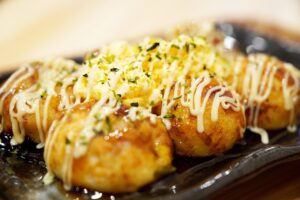The air in Dotonbori is thick, a humid soup of savory smoke, sweet takoyaki batter, and the faint, electric tang of ozone from a million points of light. It’s a place that assaults the senses in the most magnificent way, a river of humanity flowing beneath colossal, blinking advertisements. Giant crabs wave their mechanical claws, a pufferfish glowers with internal light, and the Glico Running Man sprints endlessly toward a victory he’ll never reach. This is Osaka’s kitchen, its vibrant, beating heart, and I’m here for one thing: the soul food of the city, served on a stick. I’m talking about kushikatsu, those perfectly deep-fried skewers of meat, seafood, and vegetables that are as fundamental to Osaka as the dialect spoken in its streets. But in this dazzling labyrinth of culinary choices, a fundamental question arises for any traveler seeking authenticity. Do you follow the bright lights to the famous, bustling chain restaurants, with their iconic mascots and clear-cut rules? Or do you duck into a shadowed alley, slide open a rickety door, and take a chance on a tiny, independent spot where the owner knows every regular by name? This isn’t just a choice between two meals; it’s a choice between two entirely different stories of Osaka, two ways of experiencing its legendary culture of kuidaore—eating until you drop. Tonight, with my camera and my appetite, I’m diving into both, searching for the truth in the crunch, the sauce, and the soul of the city’s favorite fried food.
For those seeking other culinary adventures beyond kushikatsu, you can explore the vibrant halal food scene in Nippombashi.
The Neon-Soaked Arena: Stepping into a Kushikatsu Chain

You see them before you hear them. Light spills from their wide-open storefronts, casting the pavement in bright primary colors. The most famous of all, Kushikatsu Daruma, is an institution, its mascot a formidable, slightly stern man with folded arms—a guardian of flavor whose serious face is plastered everywhere. His image guarantees consistency, setting the standard for the experience. Stepping inside feels like entering a well-oiled machine built for maximum enjoyment and efficiency. The first thing you notice is the roar of the crowd—a joyful mix of tourists and locals, clinking beer mugs, and the steady, rhythmic sizzle from rows of deep fryers. The air is warm and hazy with cooking aromas, but it’s a clean, inviting scent, not the heavy grease of lesser places. It’s the smell of pure, unfiltered fun.
Finding a seat is an exercise in organized chaos. A staff member with a commanding voice directs you swiftly to a spot at the long counter or a small table, much like an air traffic controller. Everything is bright, polished, and purposeful. The menus are often multilingual, filled with glossy photos that take the guesswork out of ordering. There’s no need to fumble through broken Japanese; you simply point. It’s a welcoming system, designed to ease first-time visitors gently into the world of kushikatsu without any intimidation. This is hospitality on a grand scale, a performance honed over thousands of evenings.
The Mascot’s Welcome: An Icon of Osaka’s Appetite
Daruma’s angry mascot is more than branding; he’s a symbol of Osaka’s bold, straightforward personality. He doesn’t smile or beckon shyly. He stands firm, as if saying, “This is the real deal. We take our fried food seriously here, and so should you.” This figure is a familiar shorthand, instantly recognizable to anyone who’s spent even a few minutes in the city. He represents a promise: you’ll receive exactly what you came for. Good, honest, crispy kushikatsu, served fast and hot. In a city as overwhelming as Osaka, this kind of reliability is a comfort. Chain restaurants, with their familiar logos and standardized layouts, serve as anchors in the swirling sea of Dotonbori. They are lighthouses guiding hungry diners to a safe, satisfying harbor. Their presence testifies to a proven formula—a flavor profile and experience that consistently delights the masses. It’s a democratic style of dining where everyone, from visiting families to local salarymen, shares the same ritual.
The Unbreakable Rule: The Ceremony of the Sauce
Even before your first skewer arrives, the ritual begins. A communal stainless-steel container filled with dark, glossy tonkatsu-style sauce sits at the center of the counter or table. Along with it comes the cardinal rule—the sacred law of kushikatsu: NO DOUBLE-DIPPING. Signs in Japanese and English proclaim it on the walls. Staff repeat it in stern yet friendly tones. This is not merely a suggestion; it’s a cornerstone of the dining experience. The sauce is shared by all, and dipping a skewer a second time after taking a bite is a serious breach of hygiene and etiquette. This rule elevates the simple act of eating into a shared, respectful ceremony. You have one chance, and one chance only, to coat your piping-hot skewer in that tangy, slightly sweet sauce. If you need more, you use the complimentary cabbage leaves provided. These act as a spoon, a fresh, crunchy vessel to scoop up sauce and drizzle it over your skewer. It’s an ingenious system—both practical and deeply cultural. At a busy chain, watching dozens of diners adhere to this rule together is a remarkable sight. It’s a moment of shared understanding, a collective agreement that unites strangers at the counter in one delicious tradition.
A Symphony of Crunch: What to Expect on Your Plate
The moment of truth arrives. A plate of freshly fried skewers lands before you, each one perfectly golden-brown. The batter, made from fine panko crumbs, is impossibly light and crispy, shattering with a satisfying crunch at the slightest pressure. It’s a texture both delicate and deeply gratifying. The menu at the chain is essentially a greatest-hits collection. You’ll find classics: kushi-katsu (pork), ebi (shrimp), renkon (lotus root), shiitake mushrooms, and gooey melting cheese. The ingredients are of high quality but standardized. The pork is always juicy, the shrimp always has that snap, and the lotus root is consistently crisp-tender. This is the chain’s strength—predictability is a virtue. You know the experience tonight will match the one you had last year and the one you’ll have next year. The kitchen’s speed is astonishing. Skewers fly from fryer to plate in minutes, ensuring peak temperature. You dip, crunch, sip ice-cold draft beer that cuts through the richness, and reach for the next skewer. It’s a hypnotic, addictive rhythm, explaining why these places are packed every night. Kushikatsu, perfected into a science—a flawless delivery of crispy, savory joy.
The Back-Alley Heartbeat: Discovering the Local Kushikatsu-ya
To discover the other side of Osaka’s kushikatsu spirit, you must leave behind the main streets of Dotonbori. Instead of following the giant, glowing billboards, you need to explore the yokocho—the narrow side alleys that branch off like capillaries from the bustling thoroughfare. Here, the harsh neon lights soften into the gentle, singular glow of a paper lantern hanging above a small sliding door. There’s no massive mascot, no multilingual menu displayed outside, and perhaps not even a plainly readable name. Instead, there is just a noren—a traditional fabric curtain—and the muffled sounds of laughter and conversation drifting from inside. This is where you’ll find the independent shops, the beloved family-run treasures that have served the neighborhood for decades.
Pushing aside the noren and stepping in feels like entering a secret space. The room is small, often seating no more than ten or twelve people around a single, well-worn wooden counter. The air is heavy with the rich, intricate aromas of seasoned frying oil, cigarette smoke, and a faint hint of dashi. The atmosphere is intimate and personal. Dim lighting casts long shadows, and the walls are usually covered with faded posters, handwritten menus, and photos of smiling regular customers. Here, you’re not just a customer in a business; you are a guest in someone’s domain. The master of this realm, the taisho, stands on the other side of the counter, his movements efficient and practiced—a quiet ballet of dipping, breading, and frying.
Through the Noren Curtain: Stepping Into a Different World
The contrast with polished chain restaurants is immediate and striking. Where chains are loud and expansive, these local spots are quiet and enclosed. Conversations are hushed, while the main sounds are the gentle sizzle from the fryer and the soft-spoken instructions the taisho gives to his assistant. A sense of history is carved into the wood of the counter, worn smooth by the elbows of countless diners over the years. The clientele is different here, too. Although some adventurous tourists might appear, the majority of guests are locals—office workers stopping by for a drink after work, elderly couples enjoying their weekly date night, or friends catching up in a familiar spot. This sets a unique social mood. You become an observer, a temporary participant in a longstanding community ritual. There is a quiet intimacy here that the larger chains, despite their energy, cannot replicate. It is a place that invites you to slow down, to watch, to listen, and simply to be present.
The Taisho’s Craft: A Personal Touch in Every Skewer
At a small, independent kushikatsu shop, you’re not just eating food—you’re witnessing a craft. The taisho isn’t an anonymous cook in a large kitchen; he is the heart and soul of the place. Often, he personally selects the ingredients each morning at the market. He follows his own secret recipe for the batter and dipping sauce, passed down through generations or refined over a lifetime. Watching him work is captivating. He moves with quiet confidence, his hands a blur as he skewers a piece of fish, dips it into the batter, coats it with panko, and gently lowers it into the hot oil. He knows the exact moment to retrieve it, when it has achieved the perfect golden, crispy finish. He might not speak much English, but a connection forms through the food. He places a skewer on the metal tray in front of you, perhaps naming it in Japanese with a gesture. You eat, nod in appreciation, and a subtle smile may cross his face. This is a transaction built on respect—you honor his life’s work, and he shares a piece of his culinary heritage. The skewers themselves reveal this personal touch; their shapes might be slightly irregular, the batter a bit darker or lighter than that of the chains, but they carry a character, a soul that only comes from a single pair of hands.
Flavors Beyond the Familiar: The Joy of Discovery
Menus in these local spots are often handwritten, taped to the wall, and entirely in Japanese. This can feel daunting but also invites adventure. Here you’ll find skewers not featured on the glossy menus of big chains—seasonal specialties like autumn ginkgo nuts or delicate bamboo shoots in spring. You might encounter more unusual meat cuts, unique local vegetables, or creative dishes that are the taisho’s personal specialties. The best way to order is to use the magic word: omakase, meaning “I’ll leave it up to you.” This entrusts your meal to the chef’s judgment. He will observe your reactions, discern your preferences, and serve a curated selection of his finest offerings—a journey through the flavors he treasures most. You might be served a perfectly fried quail egg, its yolk still delightfully runny inside a crispy shell, or a skewer of kisu (sillago fish) so delicate it melts in your mouth. You might even try something unidentifiable—a delightful mystery of taste and texture. The dipping sauce will likely differ, perhaps spicier, sweeter, or richer in umami than mass-produced versions. This is the pleasure of the local spot—the excitement of discovery and the joy of tasting something unique and fleeting, a flavor that lives only within these four walls.
A Tale of Two Tastes: More Than Just Food

Ultimately, choosing between a kushikatsu chain and a local spot in Dotonbori isn’t about deciding which is “better.” Claiming one is superior misses the entire point. They don’t compete; rather, they represent two sides of the same coin—distinct expressions of Osaka’s profound and enduring love for food. Each offers a different experience, caters to different moods, and fulfills varied needs. To fully appreciate the city’s culinary scene, you need to experience both. The chains provide a lively, welcoming, and unmistakably modern Dotonbori vibe, celebrating Osaka’s commercial spirit and its confident presentation of culture to the world. Meanwhile, the local spots offer a glimpse into the city’s soul, preserving tradition and community just beyond the neon glow. They remind us that even in this ultra-modern city, the deepest connections often happen in the smallest, quietest spaces.
Atmosphere is Everything: The Social Fabric of Dining
Think of it like choosing between a blockbuster film and an indie movie. The chain is the summer blockbuster: exciting, loud, visually dazzling, and crafted for mass appeal. It’s where you gather a big group of friends for guaranteed fun, a high-energy night out. The local spot is the indie film: quieter, more subtle, and demanding a bit more of your focus. You visit alone or with a close friend, seeking a more thoughtful and intimate experience. You leave not just satisfied but with a story, an emotion, a connection to the creator behind the food. One offers spectacle, the other intimacy. Both are valuable and valid forms of entertainment—and in Osaka, both represent authentic ways to dine. The city’s social fabric is woven from both—the large, public celebrations and the quiet neighborhood gatherings. By dining at both, you gain a fuller understanding of what it means to eat, drink, and live in this remarkable city.
The Kuidaore Philosophy: Eating Until You Drop, Osaka Style
The coexistence of these two dining styles perfectly expresses Osaka’s kuidaore philosophy. This famous phrase, meaning “eat until you drop” or “eat yourself into ruin,” isn’t about mere indulgence; it embodies a deep, passionate, and discerning love for food in all its forms. It’s about valuing good food and memorable moments over material possessions. An Osakan will eagerly line up for the city’s renowned takoyaki, just as readily visit a no-name udon shop run by the same family for generations. The culture honors both iconic dishes and hidden treasures. The chains exemplify kuidaore on a grand scale, making signature foods accessible to all. The local spots represent the heart of kuidaore, where the love for food is expressed as craft, not brand. To truly embrace kuidaore, you must be willing to try everything: follow the crowd one night, get lost down an alley the next, all in the unstoppable pursuit of the next delicious bite.
Your Dotonbori Kushikatsu Quest: A Practical Guide
Setting off on your own kushikatsu adventure in Dotonbori is one of the true joys of travel. Whether you’re a seasoned foodie or a curious first-time visitor, a few practical tips can help you fully enjoy this world of fried delights. The key is to arrive hungry and open-minded. Everything else is just detail.
Navigating the Neon Jungle: Getting There and Getting Around
Dotonbori lies at the vibrant heart of Osaka’s Minami (South) district and is very easy to reach. The nearest major transport hub is Namba Station, served by several subway lines (Midosuji, Yotsubashi, Sennichimae) as well as major train lines like the Nankai and Kintetsu. From any of the station’s many exits, it’s just a five-minute walk to the iconic canal and surrounding streets. The best time to experience Dotonbori at its most dazzling is at night, when the neon signs blaze and the crowds are at their peak. This is when the area truly pulses with life. While the main streets can be very crowded, don’t hesitate to explore the smaller side alleys. Here, you’ll find quieter paths and hidden culinary gems. Wear comfortable shoes, as you’ll be walking and standing a lot. And be ready for a sensory overload—in the best way possible.
The Language of the Skewer: How to Order Like a Pro
Ordering at a chain restaurant is straightforward. Picture menus make it easy to point and choose, and many places offer set menus or combos that are ideal for beginners. You simply tell the staff what you want or fill out an order sheet. At a smaller, local spot, ordering might be more challenging but far more rewarding. If there isn’t an English menu, this is your chance to be brave. The word omakase (chef’s choice) will be your ally. Alternatively, learning a few key words for common ingredients can help: buta (pork), ebi (shrimp), nasu (eggplant), renkon (lotus root), tamanegi (onion). You can also look at what others nearby are eating and point to something appealing, saying “kore, kudasai” (this one, please). Most taisho (staff) are happy to assist curious visitors. Don’t worry about mistakes—your effort will be appreciated. When finished, simply say “o-kaikei, onegaishimasu” (the bill, please). The staff will tally the skewers on your plate to calculate the total—the skewers themselves act as your receipt.
Beyond the Fryer: Pairing and Pacing Your Meal
Kushikatsu is meant to be savored, not rushed. It’s best enjoyed leisurely, paired with drinks and side dishes. The undisputed favorite pairing is a cold, crisp Japanese draft beer (nama biiru). The bitterness and carbonation perfectly complement the rich fried batter, cleansing your palate and readying you for the next skewer. Highballs (whisky and soda) are another popular choice. Between skewers, snack on the complimentary cabbage leaves. Their fresh, watery crunch offers a great textural contrast and helps cut through the richness. Many places also serve other side dishes like doteyaki (slow-cooked beef tendon in miso) or simple potato salad. Don’t try to eat everything at once—order a few skewers at a time to ensure they arrive hot and fresh from the fryer. This is a marathon of flavor, not a sprint.
A Photographer’s Final Frame: Capturing the Soul of the Skewer

As a photographer, what captivates me most about this culinary duel is the light. In chain restaurants, the lighting is bright, even, and unyielding—a commercial glow designed to make the food appear vibrant and the customers look cheerful in their selfies. It’s stage lighting, where every meal becomes a public performance. But in the quiet back alleys, the light changes. It comes from a single, warm source—perhaps a bare bulb or a paper lantern—that shapes the scene out of the darkness. It captures the steam rising from a freshly fried skewer, sparkles off a glass of beer, and casts the taisho’s face in dramatic shadow. This is a narrative light, rich with mood and mystery. Capturing that light, that contrast, is like capturing the dual soul of Osaka itself. One frame reveals the city’s brilliant, modern, and outgoing face; the other unveils its quiet, traditional, and introspective heart. Both are beautiful. Both are genuine. Both are delicious.
So when you find yourself standing beneath the gaze of the Glico Running Man, wondering where to get your kushikatsu fix, the answer is simple: do both. Begin your evening in the bright, buzzing energy of a well-known chain. Feel the crowd’s pulse, follow the famous rule, and savor the flawless, crispy classics. Establish your benchmark, your foundation for what this food truly represents. Then, when you’re ready, slip away from the main street and start your hunt. Look for that dimly lit doorway, that simple noren curtain. Slide open the door and step back in time. Trust in the hands of a master and let him show you what a lifetime of dedication tastes like. You will leave Dotonbori not just with a full stomach, but with a richer, more complete story of Osaka—a tale told one golden, crunchy, unforgettable skewer at a time.








